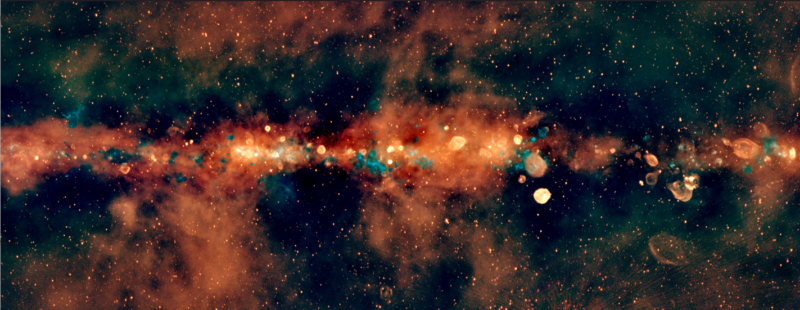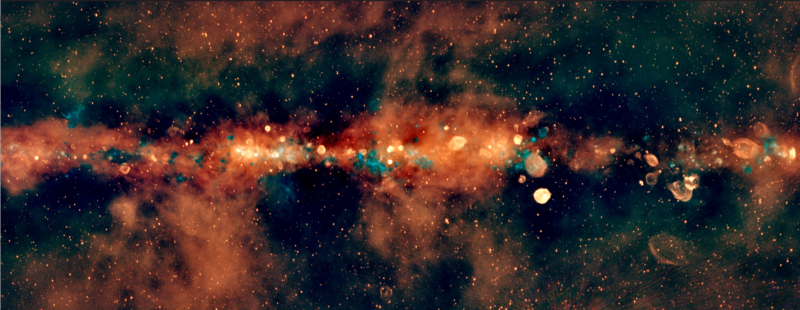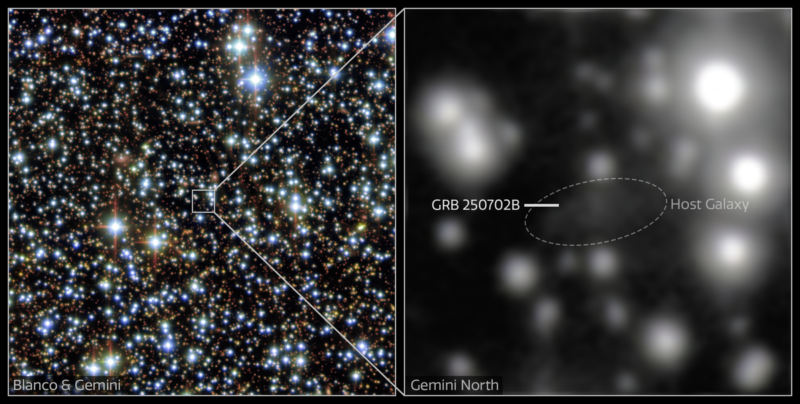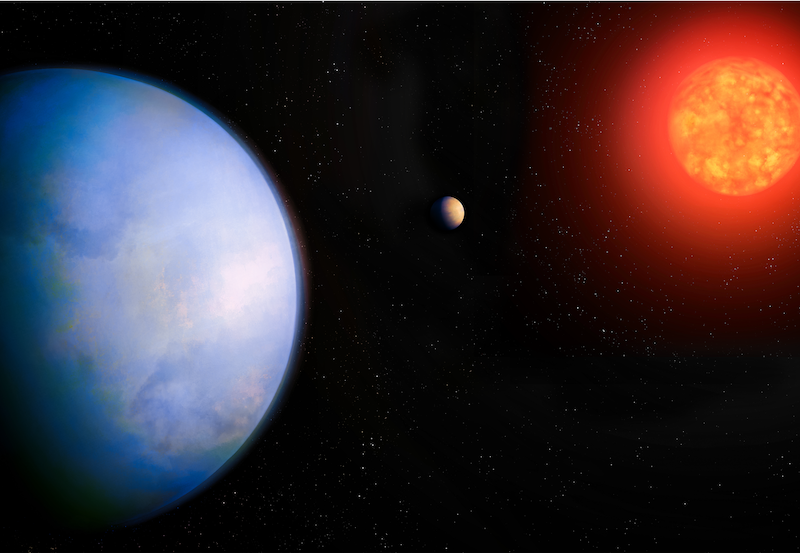Now Reading: A view of the Milky Way galaxy in unprecedented radio color
-
01
A view of the Milky Way galaxy in unprecedented radio color
A view of the Milky Way galaxy in unprecedented radio color


- The Milky Way is our home galaxy. It glows not just in visible light but in light from all wavelengths of the spectrum, including radio waves.
- Radio waves allow astronomers to see different properties of our universe. That includes how stars are born and how they die.
- A new map of the galaxy shows our Milky Way in unprecedented radio color. It shows the emissions of dead stars in orange and regions where stars are born in blue.
Science matters. Wonder matters. You matter.
Join our 2025 Donation Campaign today.
ICRAR published this original story on October 29, 2025. Edits by EarthSky.
The Milky Way galaxy in unprecedented radio color
On October 29, 2025, astronomers from the International Centre of Radio Astronomy Research (ICRAR) shared their creation of the largest low-frequency radio color image of the Milky Way ever assembled. This spectacular new image captures the Southern Hemisphere view of our Milky Way galaxy. And in addition, it reveals our galaxy across a wide range of radio wavelengths, or ‘colors’ of radio light. The mosaic image provides astronomers with new ways to explore the birth, evolution and death of stars in our galaxy.
Watch a video explaining the new radio map of our Milky Way galaxy. Video via ICRAR.
The researchers published their new study on October 28, 2025, in the peer-reviewed Publications of the Astronomical Society of Australia.
The Milky Way galaxy at low radio frequencies
Silvia Mantovanini, a PhD student at the Curtin University node of ICRAR, dedicated 18 months and and approximately 1M CPU hours to construct the image. She used the supercomputers at the Pawsey Supercomputing Research Centre to process and compile the data from two extensive surveys.
The surveys were conducted using the Murchison Widefield Array (MWA) telescope located at Inyarrimanha Ilgari Bundara, the CSIRO Murchison Radio-Astronomy Observatory on Wajarri Yamaji Country in Western Australia.
These were the GaLactic and Extragalactic All-sky MWA (GLEAM) and GLEAM-X (GLEAM eXtended) surveys. Overall, the GLEAM survey spanned 28 nights in 2013 and 2014. And the GLEAM-X survey went for 113 nights from 2018 to 2020.
The new image focuses on our own galaxy. It offers twice the resolution, 10 times the sensitivity and covers twice the area compared to the previous GLEAM image released in 2019.
This is a significant improvement in resolution, sensitivity and sky coverage. And so as a result, it allows for a more detailed and comprehensive study of the Milky Way. This provides astronomers with a wealth of new data and insights. Mantovanini said:
This vibrant image delivers an unparalleled perspective of our galaxy at low radio frequencies. It provides valuable insights into the evolution of stars, including their formation in various regions of the galaxy, how they interact with other celestial objects and ultimately their demise.

Spotting supernova remnants
Mantovanini’s research focuses on supernova remnants. Basically, they are the expanding clouds of gas and energy left behind when a star explodes at the end of its life. Scientists have discovered hundreds of these remnants so far. But astronomers suspect thousands more are waiting to be found.
Now, the image allows them to distinguish between the gas surrounding new stars and that left behind by dead ones. Generally speaking, it reveals clearer patterns in the cosmic landscape. Mantovanini said:
You can clearly identify remnants of exploded stars, represented by large red circles. The smaller blue regions indicate stellar nurseries where new stars are actively forming.
In addition, the image may also help unravel the mysteries surrounding pulsars in our galaxy. By measuring the brightness of pulsars at different GLEAM-X frequencies, astronomers hope to gain a deeper understanding of how these enigmatic objects emit radio waves and where they exist within our galaxy.
A catalog of 98,000 radio sources
Associate Professor Natasha Hurley-Walker from the same ICRAR team is the principal investigator of the GLEAM-X survey. Hurley-Walker emphasized how this is a big step forward in studying the Milky Way’s structure:
This low-frequency image allows us to unveil large astrophysical structures in our galaxy that are difficult to image at higher frequencies. No low-frequency radio image of the entire Southern Galactic Plane has been published before. This makes it an exciting milestone in astronomy.
Indeed, only the world’s largest radio telescope, the SKA Observatory’s SKA-Low telescope will have the capacity to surpass this image in terms of sensitivity and resolution. It is set to be completed in the next decade on Wajarri Yamaji Country in Western Australia.
Overall, the surveys involved hundreds of hours of data collection using the MWA radio telescope. The ICRAR researchers catalogued an impressive 98,000 radio sources across the galactic plane visible from the Southern Hemisphere. The sources are a diverse mix of pulsars, planetary nebulae, compact HII regions – which are dense, ionized gas clouds in space – and distant galaxies unrelated to the Milky Way.
Bottom line: Astronomers released a new radio view of our Milky Way galaxy on October 29, 2025. It’s the largest low-frequency radio color image of the Milky Way yet.
The post A view of the Milky Way galaxy in unprecedented radio color first appeared on EarthSky.
Stay Informed With the Latest & Most Important News
Previous Post
Next Post
-
 012024 in Review: Highlights from NASA in Silicon Valley
012024 in Review: Highlights from NASA in Silicon Valley -
 02Panasonic Leica Summilux DG 15mm f/1.7 ASPH review
02Panasonic Leica Summilux DG 15mm f/1.7 ASPH review -
 03From Polymerization-Enabled Folding and Assembly to Chemical Evolution: Key Processes for Emergence of Functional Polymers in the Origin of Life
03From Polymerization-Enabled Folding and Assembly to Chemical Evolution: Key Processes for Emergence of Functional Polymers in the Origin of Life -
 04How New NASA, India Earth Satellite NISAR Will See Earth
04How New NASA, India Earth Satellite NISAR Will See Earth -
 05And Thus Begins A New Year For Life On Earth
05And Thus Begins A New Year For Life On Earth -
 06Astronomy Activation Ambassadors: A New Era
06Astronomy Activation Ambassadors: A New Era -
07SpaceX launch surge helps set new global launch record in 2024




















